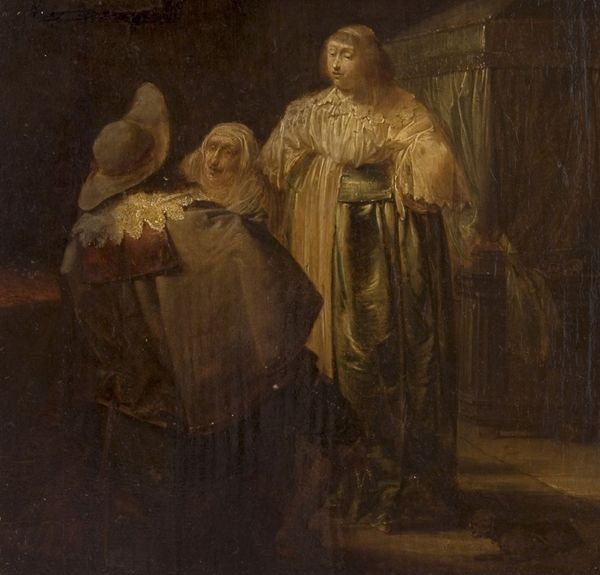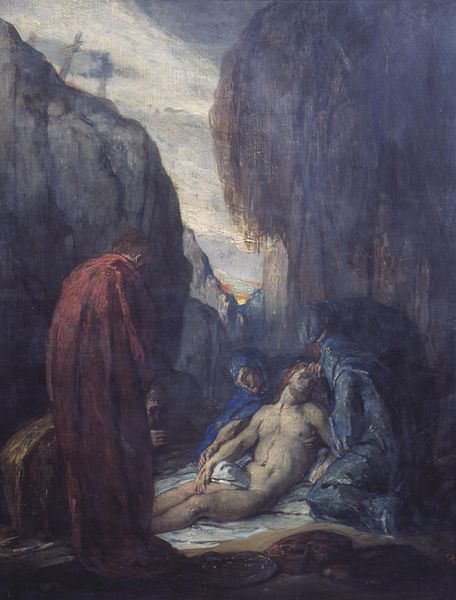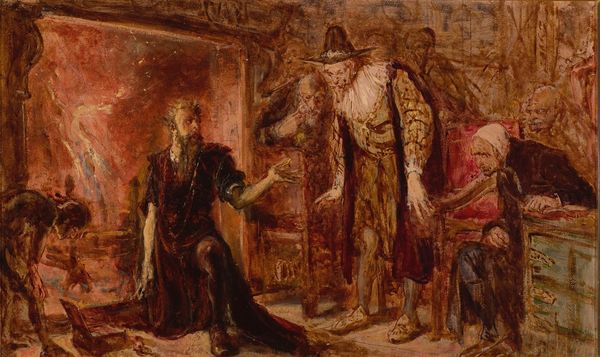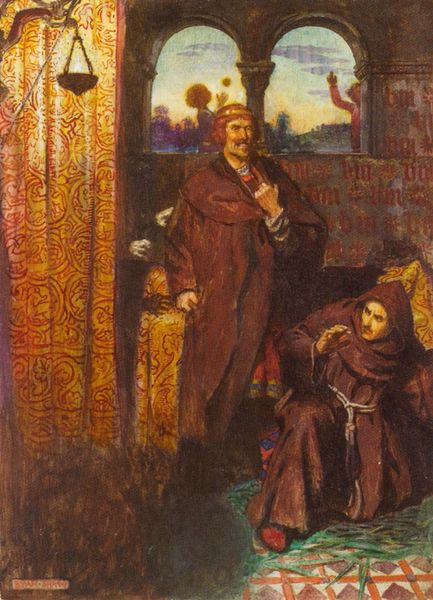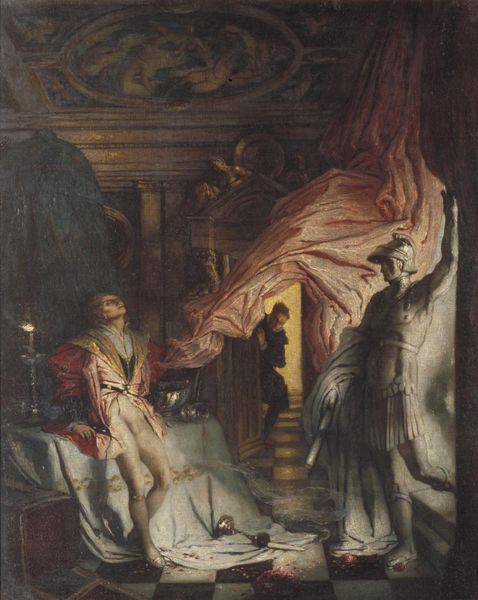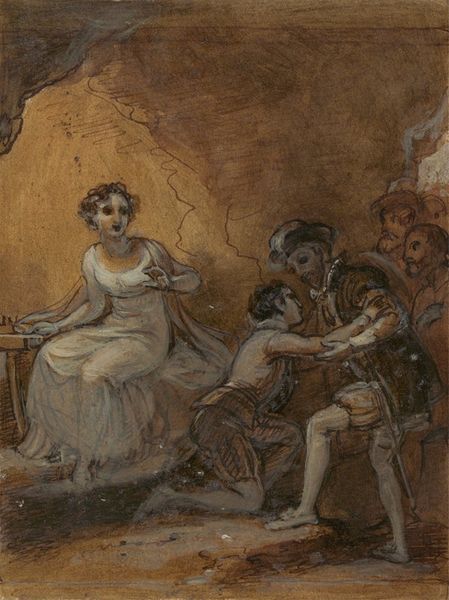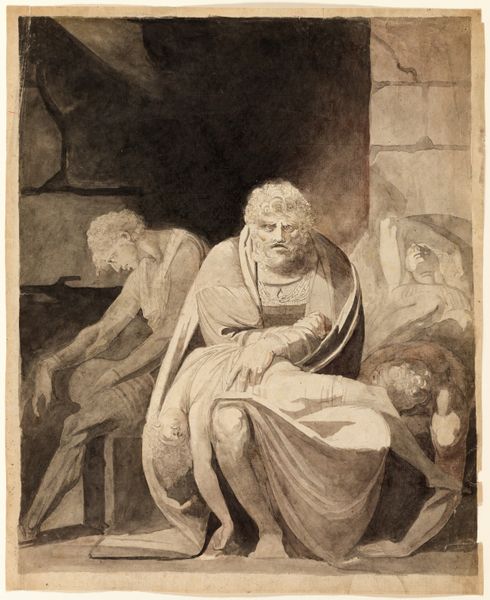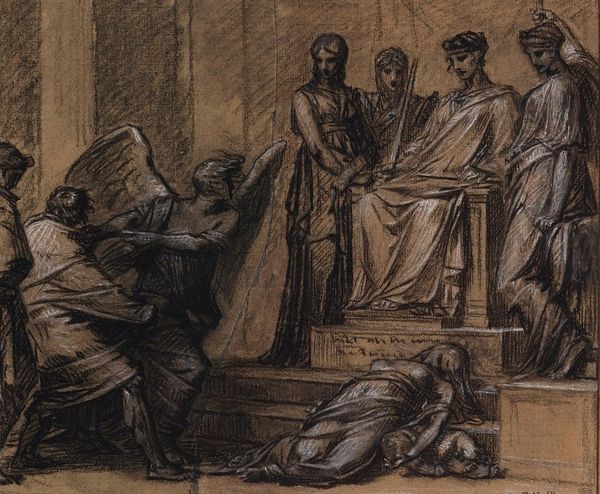
Dimensions: support: 2743 x 1505 mm
Copyright: CC-BY-NC-ND 4.0 DEED, Photo: Tate
Curator: Oh, what a scene. It feels like twilight, doesn't it? Everything bathed in that hazy, crepuscular light... a moment of profound stillness. Editor: Indeed. We're looking at "The Messenger" by George Frederic Watts, held at the Tate. Notice Watts's masterful use of impasto, creating tangible texture in the figures' robes. The layering of pigment is quite thick. Curator: Yes, and it's not just technique, but feeling... that weary hand reaching out, the ethereal figure holding what appears to be a sleeping child. It whispers of mortality, of transitions. Do you see the violin abandoned on the floor? Editor: I do. Abandoned tools speak volumes, don't they? It's a potent commentary on the role of labor and creativity in the face of… well, the inevitable. What kind of social structures allow an artist to reflect so profoundly on mortality? Curator: Perhaps Watts was pondering the weight of Victorian society itself, all its striving and ambition, set against the grand, indifferent sweep of time. Editor: Or maybe it's about how the very materials of art – the pigments, the canvas – are themselves subject to decay, a constant reminder of impermanence. Curator: It’s a beautiful, melancholy thought to carry with us, isn't it? Editor: Certainly, Watts makes us think deeply about what materials, labor, and time can convey.
Comments
Join the conversation
Join millions of artists and users on Artera today and experience the ultimate creative platform.
tate 8 months ago
⋮
The Messenger, also known as 'The Message of Peace' and 'The Messenger of Death', is one of a series of compositions by Watts that engage with the theme of death ; others include 'Sic Transit' (1890-2) (Tate N01638), Time, Death, and Judgement (c.1889-1900) (Tate N01693), and The Court of Death (c.18780-1902) (Tate N01894). The Messenger was among those works that Watts presented to the Nation in 1897, and which are now held in the Tate collection. This work is the first of two large versions of the composition, the second of which is now in a private collection. A very large charcoal drawing of The Messenger is in the Watts Gallery, Compton. This drawing was left unfinished until 1904 when Watts, wishing to replace the Tate work with a 'reconsidered' version, began to paint over this sketch, but died before he could complete it. A small oil sketch in brown and grey monochrome, bearing the same date as the Tate version but simpler in design, is also at Compton. There is a further small drawing of the composition done in black and red chalk in the Lanigan Collection, Canada. The Tate version of The Messenger was shown in the exhibition of Watts's work at the New Gallery in 1896-7. Watts wrote a prefatory note in the catalogue for this exhibition, in which he described many of his compositions. He wrote of this painting: ' "The Messenger" announces repose after life's work. The same power takes charge of Innocence, placing it beyond the reach of evil' (The Works of G.F. Watts R.A., exhibition catalogue, New Gallery, London 1896-7, p.6). The catalogue entry for The Messenger reveals that it is the moment of death that is depicted: 'A man, worn out with suffering, leans back in his chair; at his side lie the insignia of the various arts now of no more avail; and near him stands the Messenger of Death, who holding an infant on her left arm, touches him with her right hand and bids him come' (The Works of G.F. Watts R.A., exhibition catalogue, New Gallery, London 1896-7, p.57, no.134). The figure of Death in The Messenger is the same benign, female figure which appears in all of Watts's works on the theme of death. The baby which she carries on her arm is comparable with the baby on Death's lap in The Court of Death, of which Watts remarked: 'even the germ of life is in the lap of Death' (quoted in Lanigan, p.232). The assortment of symbolic accessories, such as the globe and the violin, are comparable with similar items in Watts's later picture, 'Sic Transit' (1890-2). Barbara Bryant has suggested that Watts may have derived this motif from the vanitas still-life, 'with its focus on the fragility of man and the transcience of life and beauty' (Wilton and Upstone, p.270). Further reading:Andrew Wilton and Robert Upstone (eds), The Age of Rossetti, Burne-Jones and Watts: Symbolism in Britain, 1860-1910, exhibition catalogue, Tate Gallery, London 1998, p.74, reproduced p.74, fig.44.Dennis Lanigan and Douglas Schoenherr, A Dream of The Past: Pre-Raphaelite and Aesthetic Movement Paintings, Watercolours and Drawings from the Lanigan Collection, exhibition catalogue, University of Toronto Art Centre, Toronto 2000, pp.231-3. Rebecca ViragJuly 2001
